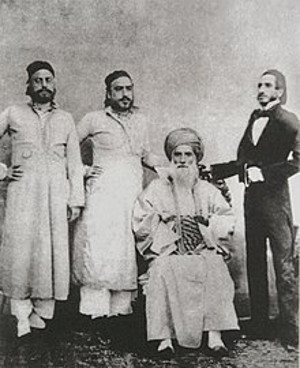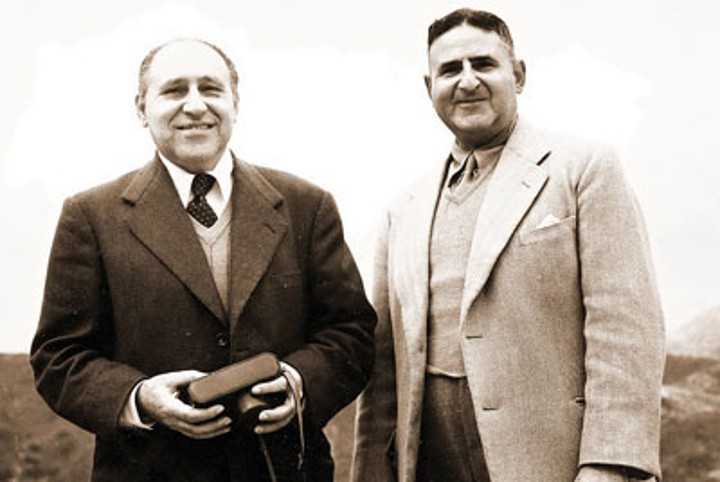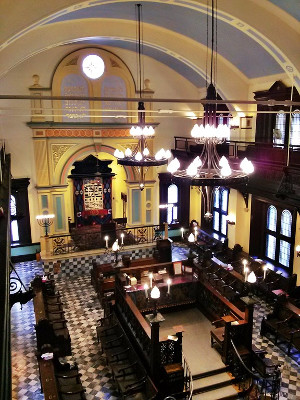 Iran’s Attack on Israel
Iran’s Attack on Israel

Jewish Geography

Jewish Geography
9 min read
Hong Kong’s vibrant Jewish community mirrors the growth of the city.
Hong Kong’s has been making headlines across the world, as millions of protestors take to the streets, demanding to preserve their independent legal system and prevent extradition to mainland China. Hong Kong, a Special Administrative Region of the People’s Republic of China, boasts over 7 million residents, including 5,000 Jews.
Hong Kong’s Jewish community dates to the mid-1840s and has contributed to the rise of Hong Kong from a sleepy backwater to the global, dynamic region it is today. Here are six surprising facts about this robust community.
 David Sassoon (seated) with his sons
David Sassoon (seated) with his sons
Elias, Albert and David Jr.
Baghdad was traditionally home to a thriving Jewish community that traced its roots to the time of the destruction of the First Temple in Jerusalem in 587 BCE. One of the most prominent Iraqi Jewish families was the Sassoons, who were treasurers to the Governors of Baghdad. In 1826, David Sassoon left his position as treasurer and moved his family first to Persia and then onto India. He became a major trader, buying and selling the riches of the east: silk, cotton, tea, silver and opium. An Orthodox Jew and major philanthropist, David established synagogues in Bombay and Pune, India, and funded schools and hospitals throughout Asia.
David had eight sons, and each built a major business outpost in Asia, establishing family offices in Burma, Canton, Indonesia, Japan, Singapore – and Hong Kong, which was then a sleepy fishing port. The Sassoon family and their employees helped build up the territory and formed the core of Hong Kong’s earliest Jewish community. They were religiously observant and for years the Sassoons and their colleagues held services daily in their homes and offices.
In 1901, the small Jewish community of Hong Kong began construction on a synagogue, and in 1902 Ohel Leah, named after David Sassoon’s wife, opened its doors.
 Arthur Sassoon
Arthur Sassoon
After Hong Kong was handed to Britain in the Treaty of Nanking in 1842, both Hong Kong and Shanghai emerged as major centers of banking, financing the growing trade between India, Europe and China. Merchants increasingly demanded sophisticated banking services, and in 1865, Arthur Sassoon, one of David Sassoon’s sons, joined others in a provisional committee to establish what became the Hong Kong and Shanghai Banking Corporation, lending funds and turning Hong Kong into one of the world’s great banking hubs.
Arthur’s brother Frederick Sassoon served on Hong Kong’s Legislative Council in the 1880s. Years later, from 1904 to 1907, Hong Kong had a Jewish governor, Matthew Nathan, who helped to develop the Kowloon area of the city, which today is one of Hong Kong’s most beautiful and dynamic areas.
The earliest Jewish establishment in Hong Kong was the Jewish cemetery, purchased in 1855. The first grave, belonging to a Jew named Leon Bin Baruel, dates from 1857. The cemetery continues to be in use today.
 Matthew Nathan
Matthew Nathan
Matthew Nathan was born into a Jewish family in London and became an engineer, eventually entering Britain’s civil service. He was sent to Hong Kong where the muddy, swampy area of the territory named Kowloon caught his eye. Judy Green, the Chairwoman of the Jewish Historical Society of Hong Kong, explains that her husband’s grandfather remembered Nathan “walking around (Kowloon) in gumboots because it was a swamp. Nathan decided that for Kowloon to flourish it needed an access road to link it to the hinterland of the New Territories. Many thought he was making a mistake but he was determined to push the project through.”
Nathan’s engineering background helped him to visualize what the unpleasant area of Kowloon might one day become. He established Hong Kong’s first urban planning office and pushed to develop the swampy area of Kowloon, envisioning a major thoroughfare running through it. The resulting road is called Nathan Road, one of Hong Kong’s busiest avenues. Sceptics dubbed the street “Nathan’s Folly” at the time. Today, it is sometimes called the “golden mile”, and Nathan Road is one of the greatest shopping destinations in Asia.
 Nathan’s Road today
Nathan’s Road today
 Emanuel Rafael Belilios
Emanuel Rafael Belilios
As Jewish businessmen and their families moved to Hong Kong, some helped to make the burgeoning city more colorful with their eccentric hobbies and activities, and a richer, more cultured place. Emanuel Rafael Belilios (1837-1905) was a Jewish trader who built a large house on the luxurious area known as The Peak, complete with an exotic zoo in his garden. He was appointed to the Legislative Council in 1881 and gave generously to Hong Kong charities, including helping back the Alice Memorial Hospital, founding the Belilos School for Boys in 1900, and helping build Hong Kong’s first girls’ school.
Harry Odell (1896-1975) worked as a tap dancer in Japan before moving to Hong Kong in 1921 and settling down with a nice Jewish Hong Kong girl, Sophie Weill. He fought in the Battle of Hong Kong (waged on the same day as Pearl Harbor) and survived a Japanese POW camp. After World War II, he started a film distribution company, invited celebrities to visit Hong Kong, and lobbied the government to build the City Hall auditorium.
 Harry Odell
Harry Odell
Dr. Solomon Bard (1916-2014) was born in Siberia and moved with his family to China as a child. He attended medical school in Hong Kong in the 1930s and served as a medic during the Battle of Hong Kong. In 1956, he became the Director of University Health Services at the University of Hong Kong. A gifted violinist, Dr. Bard also served as Chairman of the Hong Kong Philharmonic Orchestra and in other cultural institutions, helping expand Hong Kong’s music and arts scene.
Lawrence and Horace Kadoorie were known for decades for their philanthropy – and for helping their Jewish brethren after World War II, when many Jews were penniless and homeless refugees, in their greatest hour of need.
The Kadoorie family was from Iraq and, like the Sassoons, moved to India and then to Hong Kong. Their father Elly Kadoorie arrived in Hong Kong in 1880 at the age of 15 in order to work with the Sassoon’s company. He was eventually joined by his brother Ellis, and the two invested in hotels in Hong Kong and Shanghai. The famous Peninsula Hotel in Hong Kong was one of their ventures; when it opened in 1928 it was called “the finest hotel east of the Suez”. Though it was then the only hotel on the otherwise empty Kowloon waterfront, Elly Kadoorie saw its potential; the hotel and the area thrived, and the Peninsula remains an iconic Hong Kong landmark to this day.
 Lawrence and Horace Kadoorie
Lawrence and Horace Kadoorie
When World War II broke out, Lawrence and his family were imprisoned in a Japanese internment camp in China. Horace and their father Elly also found themselves in China, forced to live in what had once been the family’s stables. Although they suffered greatly, the family survived the war and afterwards Lawrence returned to Hong Kong to restart the family business. He moved into the Peninsula Hotel, which was in a terrible state after being used first to house Japanese and then British soldiers.
The two brothers – Horace in Shanghai and Lawrence in Hong Kong – sprang into action to help Jewish refugees. Before the Holocaust, Shanghai was one of the world’s only jurisdictions which didn’t require a visa to enter, and about 20,000 Jews moved to the city, spending the war confined to in a cramped Jewish ghetto by Japanese forces. Horace helped galvanize Shanghai’s tiny Jewish community to aid the refugees during the war, and afterwards he and Lawrence worked to help them as they collected visas to move onto new lives in Israel, Europe, Australia and the Americas.
Many of the refugees had to travel to Hong Kong to collect their visas. Horace would collect the information about refugees heading to Hong Kong and send it to Lawrence, who visited the city’s Immigration Department nearly every day, relaying petitions for transit visas for the refugees.
Lawrence Kadoorie also opened the doors of the Peninsula hotel to the refugees, giving them a place to stay for days or sometimes weeks. One group of nearly 300 refugees was scheduled to travel to Australia and was staying in the Peninsula when the ship they were due to sail on was requisitioned to carry troops instead. Lawrence turned the grand hotel’s ballroom into a dormitory, allowing the group to stay there long term – and also organized Hong Kong’s small Jewish community to help, offering food, clothing, medicine and logistical help.
The Kadoorie family also helped poor Chinese and other groups in Hong Kong. Elly Kaddorie founded schools and hospitals throughout Asia that were open to all, regardless of religion or race; his Chinese Schools Society in Hong Kong was conceived to help educate the poor and continues to aid the region’s poorest children. As well as helping their Jewish brethren, Lawrence and Horace Kadoorie worked to help Chinese refugees fleeing to Hong Kong to escape civil war in China. One major initiative was the Kadoorie Agricultural Aid Association, which trained thousands of farmers and today is the Kadoorie Farm and Botanic Garden.
 Ohel Leah Shul
Ohel Leah Shul
In 1882, about 60 Sephardi Jews called Hong Kong home. The population grew slowly. By 1959, there were 230 Jews, evenly divided between Ashkenazi and Sephardi communities. In the 1960s, more Jews began to immigrate to the city, vastly expanding the Jewish population in Hong Kong. Today, over 5,000 Jews call Hong Kong home.
Hong Kong today boasts several vibrant synagogues, including the historic Orthodox synagogue Ohel Leah, a thriving Jewish Community Center (JCC), a mikvah, kosher restaurants, a kosher grocery store, and a Jewish school.
“The Jewish community in Hong Kong is very special,” says Hong Kong resident Erica Cohen Lyons. “It’s extremely diverse, with Jews from Europe, the Americas, the Middle East, Asia and Africa.”
Judy Green of the Hong Kong Jewish Historical Society concurs: “It’s a close-knit and dynamic community.”
Photo credit: Many of the photos come from the Jewish Historical Society of Hong Kong.
